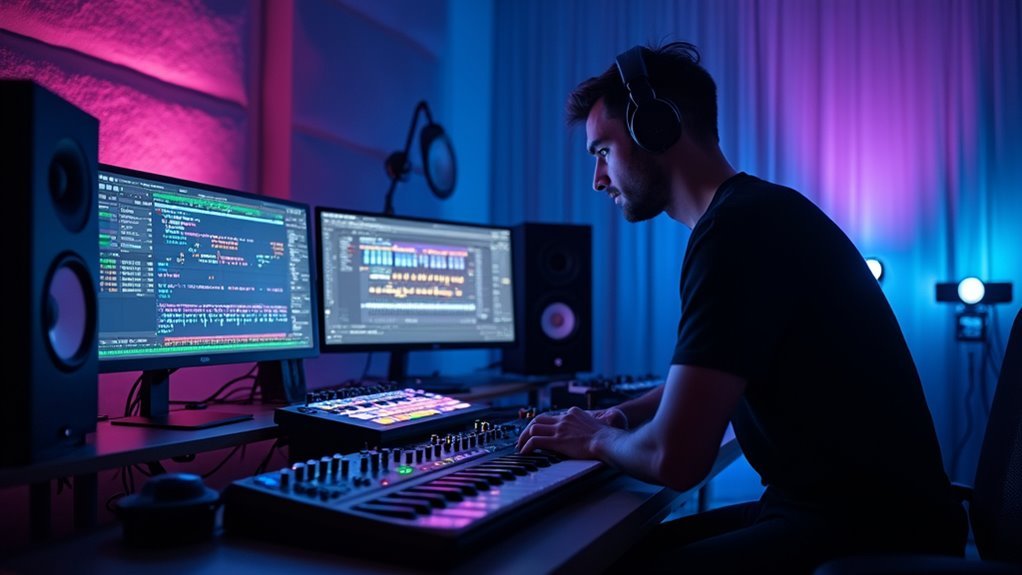EDM producers often overlook chord progressions, focusing instead on flashy synths or intricate drums. Yet these harmonic foundations determine whether a track resonates emotionally or falls flat. Most hit records rely on surprisingly simple chord structures—sometimes just three or four chords arranged effectively. Learning these essential progressions isn’t particularly difficult, but implementing them strategically can transform average productions into memorable ones. The difference between amateur and professional-sounding tracks frequently comes down to this fundamental musical element.
Master Essential Chord Progressions for EDM Success

Diving into the world of EDM production requires more than just technical skills—it demands a fundamental understanding of the musical structures that resonate with listeners.
At the heart of this understanding lies chord progressions, the emotional backbone of electronic music. Producers who master progressions like the I-V-vi-IV (like C-G-Am-F) reveal a sonic language that speaks directly to audiences.
Chord progressions are the universal language that transforms electronic sounds into emotional journeys for the dance floor.
This isn’t just about following formulas—it’s about finding your voice within established patterns that, perhaps, create that sense of familiarity listeners crave. The beauty of these progressions is their versatility.
They’re building blocks that invite both novices and veterans into a shared musical conversation, creating community through sound.
The Power of I-V-vi-IV: EDM’s Emotional Foundation

The I-V-vi-IV chord progression stands as perhaps the most recognizable harmonic sequence in modern electronic dance music.
It’s that emotional foundation you’ve heard countless times in festival anthems and radio hits—think C-G-Am-F in the key of C major.
What makes this progression so powerful is its perfect balance of uplift and melancholy.
Producers gravitate toward it because, well, it just works. The familiar pattern creates an instant connection with listeners while still offering room for creative interpretation.
For beginners especially, mastering this progression opens doors.
It’s accessible on piano, translates beautifully to synthesizers, and honestly, it’s hard to make it sound bad.
Unlocking Creativity With Ii-V-I Progressions

Jazz musicians have long understood what EDM producers are now discovering—the ii-V-I progression offers a perfect balance of tension and resolution that keeps listeners engaged.
In C major, this translates to Dm-G-C, creating that satisfying loop that feels almost magnetic.
What makes this progression special, I think, is how it builds anticipation before delivering release. Many producers find it’s particularly effective for buildups and drops, perhaps because it feels both familiar and exciting simultaneously.
The progression’s versatility is striking too—it works across tempo ranges and can be adapted to fit virtually any EDM subgenre. No wonder it’s become such an essential tool in producers’ harmonic toolboxes.
V-vii°-iii-IV: Adding Complexity to Your Tracks
When producers seek to elevate their EDM tracks beyond basic progressions, the V-vii°-iii-IV sequence offers a fascinating solution. This progression (like DF#dimBmC in G major) creates a distinctive emotional arc that many listeners find intriguing without quite knowing why.
The beauty of V-vii°-iii-IV lies in its balance between complexity and accessibility. It starts with a powerful dominant chord, moves through the tension of a diminished seventh, finds calm in the mediant, and resolves with the subdominant’s warmth.
I think this journey adds depth that more straightforward progressions sometimes lack, perhaps making your tracks stand out in an increasingly crowded genre.
Classic Pop Progressions Reimagined for Electronic Music
Many classic pop chord progressions offer untapped potential for producers seeking to inject familiar emotional resonance into their electronic productions. The I-vi-IV-V progression, perhaps one of the most recognizable sequences in music history, translates beautifully into EDM contexts while maintaining its nostalgic pull.
When reimagined with modern synths and production techniques, these time-tested progressions take on new life. The IV-I-V-vi sequence, for instance, creates a fresh take on harmony while still feeling somehow familiar to listeners.
I think this connection to musical traditions helps electronic tracks forge deeper emotional connections with audiences who might not even realize why certain melodies feel so comforting.
From Theory to Practice: Implementing Chord Progressions in Your DAW
Translating chord progressions from theoretical knowledge to practical implementation requires a systematic approach within digital audio workstations. Producers often struggle with this change, but breaking it down into manageable steps can make all the difference. I think the key is finding your preferred workflow—some producers start with MIDI clips while others prefer playing directly into the DAW.
| Approach | Benefit | Example Tool |
|---|---|---|
| MIDI Piano Roll | Visual precision | Ableton’s Piano Roll |
| Hardware Controller | Tactile feedback | Novation Launchkey |
| Chord Generator | Quick ideation | Scaler 2 Plugin |
| Audio Recording | Natural feel | Interface + keyboard |
Perhaps the most important thing to remember is that there’s no single “correct” implementation method—your personal creative process should guide your technical approach.
Creating Dynamic Builds and Drops With Strategic Chord Sequences
The heart of any compelling EDM track lies in its ability to build tension and release it through powerful drops—a technique that relies heavily on chord sequences. Perhaps the most effective approach involves manipulating familiar progressions like I-V-vi-IV to create anticipation during buildups.
Tension and release through chord manipulation is the heartbeat of memorable EDM drops.
For instance, producers might extend the vi chord before a drop, or introduce the vii° diminished chord to heighten tension.
I’ve noticed that alternating between just two chords (often V-vi) during builds creates that unmistakable “something’s about to happen” feeling that festival crowds crave.
Remember—your chord choices during changes aren’t just theory; they’re emotional signposts guiding listeners through your sonic journey.
Frequently Asked Questions
How Do Modulating Chord Progressions Impact Listener Engagement in EDM?
Modulating chord progressions create surprise and emotional shifts, maintaining listeners’ interest through harmonic tension and resolution. This progression-based journey enhances the dynamic experience, keeping audiences engaged throughout EDM tracks.
Can Chord Inversions Change the Emotional Impact of Standard Progressions?
Chord inversions absolutely transform standard progressions, shifting emotional weight by altering bass notes. These variations create smoother voice leading, unexpected tension, and fresh emotional landscapes while maintaining harmonic familiarity that resonates with listeners.
How Do Producers Adapt Chord Progressions for Different BPM Ranges?
Producers adjust chord voicings, rhythmic placement, and note durations for different BPM ranges. At slower tempos, they add complexity; faster tempos require simplified progressions with emphasized root notes for clarity.
What Hardware Synths Best Showcase Complex Chord Progressions in Live Performances?
Nearly 70% of touring EDM artists prefer polyphonic synths like Moog One, Prophet-6, and Nord Stage for live chord work. These instruments deliver rich harmonics and tactile control fellow performers appreciate.
How Do Modal Interchange Techniques Enhance Traditional EDM Chord Progressions?
Modal interchange introduces chords from parallel modes, adding emotional depth and harmonic surprise to familiar EDM progressions. Producers borrow these colorful alternatives to create distinctive tension-release dynamics that captivate listeners.
Conclusion
As producers master these chord progressions, they coincidentally discover the hidden language of EDM that speaks directly to listeners’ emotions. Perhaps what matters most isn’t just knowing the progressions, but understanding how they connect with audience experiences on the dancefloor. By balancing familiar sequences with unexpected twists, artists create that magical moment when the drop hits and everything—theory, creativity, and emotion—aligns in perfect, unforgettable harmony.